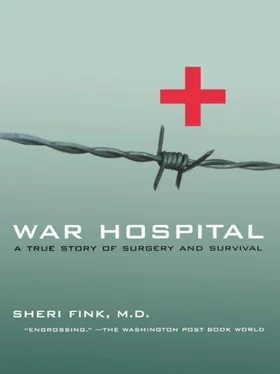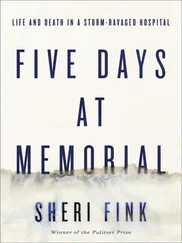Transcript of interviews with MSF local staff members and doctors in late 1995, including Emira Selimović (story about the man giving the baby to Christina).
Other Materials
Zoran Petrović footage showing men in Sandići field being forced to call for their relatives; shooting anti-aircraft guns into the hillsides. Film entitled Fall of Srebrenica (Tuzla, 1996), shows the medical staff members entering free territory.
Notes
PAGE 307 Ilijaz agrees and informs Ramiz… There is not complete agreement among interviewees as to where in the column the medical staff members were. Ilijaz Pilav says they were always in the front, whereas others recall they were in the middle until the first ambush near Kravica, and after that in the front. The same goes for Dudić’s brigade. Ilijaz believes that Dudić was in the middle, but the NIOD report says that his brigade was the last.
PAGE 308 Ilijaz’s group continues away from the sounds… The part of the Zvornik-Vlasenica road that runs between Nova Kasaba and Konjevići.
PAGE 309 They run through the tall fern… Jusef Sulejmanović, Senahid Salihović, RedŽo Babić, Mehmedalia Dedić, and Rešid Bektić. Sadik Ahmetović stayed in the back in the first shelling during the day.
PAGE 309 “What are you doing here?” One Srebrenica soldier interviewed for this book (Mensur Gadžo) said that he was part of a detail of soldiers assigned by military authorities to keep an eye out for the doctors and protect them, in gratitude for their work (there was a similar protection unit for commanders). Ilijaz denies knowing of such a unit and believes the medical group fended for themselves.
PAGE 310 “Hey, your pictures!” Ilijaz later heard that the man carrying his and Fatima’s photographs was shot and killed by the river. Some of those who crossed the river after Ilijaz and saw his photographs assumed that Ilijaz had been killed.
PAGE 311 Ilijaz asks some brigade commanders… This information is from the NIOD report, which says that the front and back weren’t in direct communication because of a problem with walkie-talkie frequency mismatch.
PAGE 311 They rely on news coming from each new group… The NIOD report contends that the reason the Serb attack was not launched immediately was that the Serb army did not know about the existence of the column until midday on the twelfth, and only then deployed all available units to attack it. This (rather than a deliberate choice to attack the middle of the column, which is also a possibility) could explain why groups toward the front of the column crossed the road with ease.
PAGES 311–312 Ilijaz tries to sleep awhile… This particular incident, not specifically recalled by Ilijaz, is noted in the Human Rights Watch report Chemical Warfare in Bosnia? The Strange Experiences of the Srebrenica Survivors , Human Rights Watch, November, 1998, Volume 10, Number 9 (D). The report speculated on use of BZ or other psychochemical incapacitant by the Serbs. Testimonial evidence was compelling but hard evidence was lacking, in part because of lack of funding to do chemical testing. HRW called for more investigation and making public the results of an investigation rumored to have been carried out by the U.S. government.
PAGE 312 The air is still and quiet… One of the Srebrenica military, Mensur Gadžo, claims that on Mt. Udrč he suggested taking the doctors by another route. The doctors were undecided until Branka Stanić (the young Croat physician) had the last word: “I was there for the whole war, and I want to be with them now.” The NIOD report suggests that all civilians on the journey were taken under the wing of one of the military units.
PAGE 314 Earlier in the evening… Naval captain Andre Schouten.
PAGE 319 “What are these buildings doing here?” Naim tells another version of this story in which Ilijaz had the hallucination while the medical group was together and Fatima slapped him awake.
PAGE 323 “Doctor, it looks like the only normal people left…” The conversation was recalled by both of them, but Hakija thought it took place at night. Hakija Meholjić insists that he saw the medical staff members take pills, refuse to share them with others, and fail to treat the injured. The medical staff members deny this.
PAGE 323 If we survive this together… Ilijaz didn’t specify exactly when in their journey he had this thought.
PAGE 326 Sometime around 2 P.M…. According to the Krstić decision: “On 16 July 1995, Lieutenant Colonel Vinko Pandurević, the Commander of the Zvornik Brigade, reported that, in view of the enormous pressure on his Brigade, he had taken a unilateral decision to open up a corridor to allow about 5,000 unarmed members of the Bosnian Muslim column to pass through.” The NIOD reports that other elements of the Bosnian army attacked the Serb lines from behind, which explains the confusing appearance of the battle to Ilijaz and the amount of firepower displayed.
Interviews
Dr. Ejub Alić, Dr. Dževad Džananović, Dr. Avdo Hasanović, Stephane Oberreit, Dr. Fatima Klempić-Dautbašić, Dr. Ilijaz Pilav, Christina Schmitz
Documents
List of Srebrenica hospital workers, “Spisak: Medicinski radnika—prognanika iz Srebrenice,” July 21, 1995, Ministry of Health, Tuzla-Podrinja Canton, Bosnia-Herzegovina.
MSF documents: Christina’s situation reports to MSF Belgrade from Potočari, July 14–21. MSF Srebrenica final situation report covering July 6–21, 1995.
Interviews
Sadik Ahmetović, Dr. Benjamin Kulovac, Dr. Boro Lazić, Sanja Lazić
Published Literature
Physicians for Human Rights, Medicine Under Siege in the Former Yugoslavia 1991–1995, pp. 58–61.
Documents
Transcript of interview with Sadik Ahmetović performed in the fall of 1995 by Laurence de Barros-Duchêne.
Krstić judgment describing the offensive on Žepa.
U.N. Srebrenica Report sections 415–431 (the capture of Žepa)
Interviews
Dr. Ejub Alić, Mubina Alić, Francis Boyle, Arthur Caplan, Dr. Eric Dachy, Rex Dudley, Kris Janowski, Dr. Boro Lazić, Sanja Lazic, Dr. Fatima Klempić-Dautbašić, Dr. Bernard Kouchner, Dr. Nedret Mujkanović, Stephane Oberreit, Dr. Ilijaz Pilav, Pierre Salignon, Christina Schmitz, Dr. Ernlie Young
Published Literature
Barry, “A bridge too far”; Coady, “The ethics of armed humanitarian interventions,” p. 34; Fink, “Physician groups and the war in Kosovo”; Holbrooke, To End a War, p. 102; Marmon et al., “The diplomat/physician in the emerging international system”; Power, A Problem from Hell, p. 419. NIOD report III/6/6 (U.S. officials received daily briefings from Dutch officials); RFE/RL December 20, 2002 (“Bosnian Muslims seek UN compensation for Srebrenica”); Physicians for Human Rights, War Crimes in Kosovo, pp. 95–97 (summary of medical neutrality concept); TimeEurope, September 11, 2002 (“A Bosnian Serb official investigation claims “exhaustion,” not massacre, killed thousands in Srebrenica,” by Anis Alić and Dragan Stanimirović), Voice of America, September 4, 2002 (“International officials denounce Serb Srebrenica report,” by Stefan Bos).
Documents
Krstić judgment.
Читать дальше












